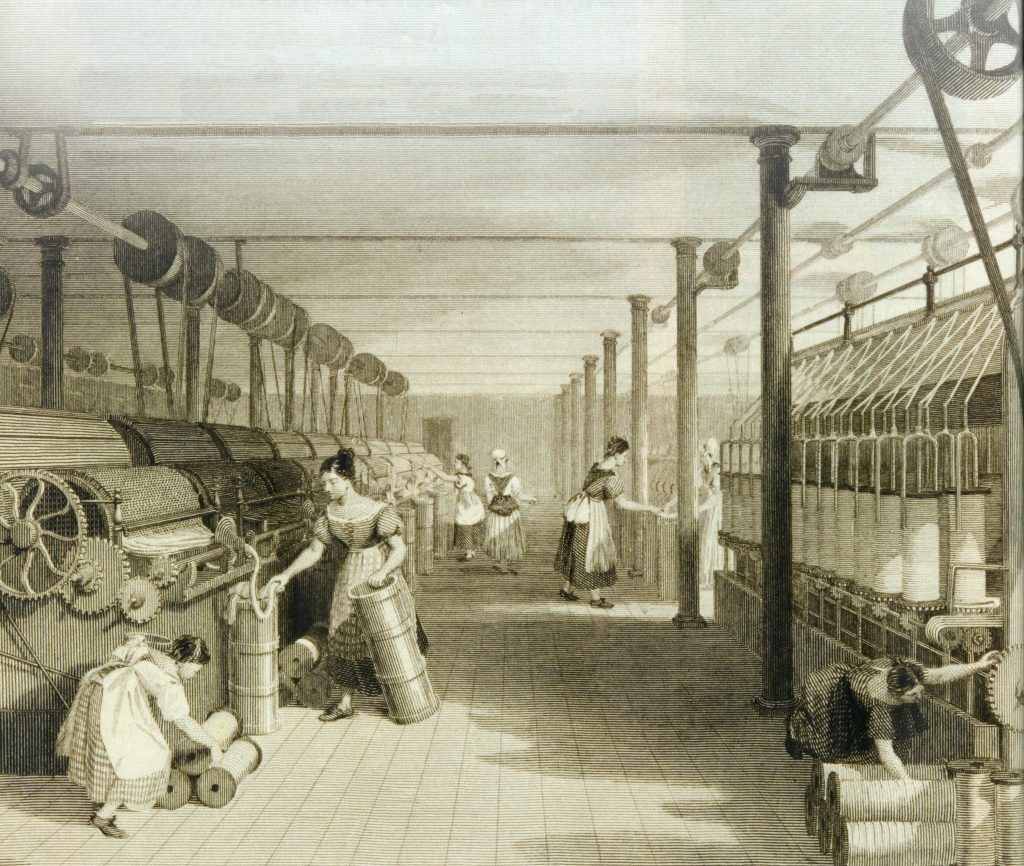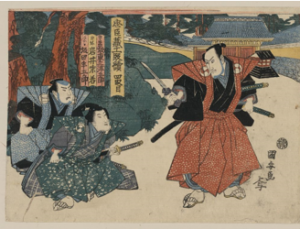Children today spend five days a week going to school for eight hours. During the first half of the nineteenth century in Britain, this was not the case. Instead, children even as young as five or six would toil all day long in factories or in mines. They had no breaks, no time off, and no schooling. Their work often led to horrible accidents, children being injured for life, and children left without an education.
Children laboring, of course, did not start with the British Industrial Revolution. It had been a normal part of life in Europe since the middle ages, when children helped their parents on farms and with household work. The people’s perception of this work, however, changed during the Industrial Revolution, since that is when people began to see this new kind of labor, factory labor, as an injustice and even criminal.1
The Industrial Revolution began in Britain during the 1780’s and rapidly changed the work process and the social relations of work. Prior to the Industrial Revolution, most people worked directly in the production of food, usually as farmers on their own farms. When textile factories began forming in the new factory cities, instead of working on their farms and making what their family needed, people left their farms and moved into the factory cities to make a living. Factory conditions of work, however, were far different from the work rhythms of farm life. In fact, they were brutal in comparison. Factory workers would typically put in between 12 and 16 hour days, working for meager wages. The machines they attended were dangerous, and the workers were often on their feet throughout the day, with perhaps a half-hour break for meals. Among these workers were children, many of whom were as young as five or six years old. Children were valued as workers for their small stature and ability to climb into small places and do things that adults often could not do. This often resulted in mutilation and the loss of appendages for many of these children.2
Children were also valued as workers by the factory owners because of the low wages that they were paid. Men were paid the most in factories, followed by women and then children. These wages, however small, were needed by the families of these children simply to survive. The parents often sent their children out to work to help pay for rent, food, and otherwise help make ends meet.3
One reason that the British public became outraged by child labor practices was the fact that children in factories were not receiving an education. Horace Mann, an American educational reformer, stated:
No greater calamity can befall us as a nation than that our children should grow up without knowledge and cultivation. If we do not prepare them to become good citizens, develop their capacities, enrich their minds with knowledge, imbue their hearts with a love of truth and all things holy, then our republic must go down to destruction as others have gone before it.4
This represents the thoughts of the British at the time, which was being echoed in the United States during its own industrial revolution. People wanted to ensure the future of their nation, which starts with the young. They believed that children should attend school for at least a while.5 This led to several laws being passed to raise the legal age of work.
In 1833, the British Parliament passed the Regulation of Child Labor law to help improve the working conditions for children in factories. The Law limited the age of workers, saying that they had to be older than nine with an age certificate to prove it, and that children 9-13 could not work for more than nine hours a day. Additionally, children 13-18 were not permitted to work longer than twelve hours a day. Along with these work-hour restrictions, the law also made school attendance a two-hour requirement, and said that children could not work at night. Fines for breaking these rules were small, however, so they were frequently violated, often with impunity.6

Many other pieces of legislation were also passed to place limits on the gender, hours, and ages of workers. The Mining Act of 1842 prevented women and girls from working in mines, and the Ten Hours Bill of 1847 set ten as the maximum number of daily working hours for women and children. This act was hated by factory owners because they believed it would hurt the textile industry’s competitiveness worldwide. After these bills, others followed to ensure their effectiveness, and to ensure that they would be properly implemented.7
By 1900, the minimum working age had been raised to twelve years of age and child labor had decreased drastically in Great Britain. However, the introduction of legislation against child labor provoked its share of protests as well. Because of these protests, Parliament established commissions to collect evidence of abusive practices. These were called the Blue Books or Sadler Reports. They interviewed children, parents, factory workers, owners, and even doctors on the condition of children in textile factories. Unsurprisingly, the reports uncovered a range of serious abuses by factory owners and overseers. Unfortunately, most critics just said that the claims were exaggerated in order to continue their money making practices.8
The legislation surrounding the British Industrial Revolution had become very effective by 1900, and child labor and its accompanying abuses had decreased dramatically. By 1900, most children were attending school instead of working in factories. The laws passed finally added up to changing British child labor to being closer to what we see today, a mostly child-free labor system, with children going to school and adults having regulated working hours.
- World History Encyclopedia, 2011, s.v. “Child Labor and Child Labor Laws in Early Industrial Great Britain.” ↵
- James D. Schmidt, “Broken Promises: Child Labor and Industrial Violence,” Insights on Law & Society, no. 3 (Spring 2010): 14–17. ↵
- Robert Whaples, “Hard at Work in Factories and Mines: The Economics of Child Labor during the British Industrial Revolution,” Business History Review, no. 2 (2001): 429. ↵
- Friends’ Intelligencer vol. 28 no. 1 (1871): 336. ↵
- James D. Schmidt, “Broken Promises: Child Labor and Industrial Violence,” Insights on Law & Society, no. 3 (Spring 2010), 14–17. ↵
- Great Britain, “Factories Regulation Act” (1833). ↵
- Steven Toms and Alice Shepherd, “Creative Accounting in the British Industrial Revolution: Cotton Manufacturers and the ‘Ten Hours’ Movement,” MPRA Paper, No. 51478 (2013), 6-8. ↵
- World History Encyclopedia, 2011, s.v. “Child Labor and Child Labor Laws in Early Industrial Great Britain.” ↵



141 comments
Tyler Sleeter
Great article. It shows how much things have changed in the area of labor over the last century and a half. It is understandable that children were expected to work on the family farms, as they still are, but when they were pushed into factory jobs, that was too much. I understand that at the time, parents needed everyone working just to survive, and that during this period children were sometimes viewed as just another mouth to feed without the special status they are given today. It is good to see that the government stepped in and protected children from the ills of labor and allowed them to get an education.
Sergio Cervantes
I cannot believe that members of society younger than us used to work in factories for long periods throughout the day. Right now, there are people who still complain about “long shifts” when in fact these kids worked way more than we do now. It shows the type of character these children possessed since they would work to help pay the bills. I find it interesting that as the years progressed different laws were enacted to protect people from the competitive textile industry that existed at the time. It’s great to see how things ended with children returning to pursue their studies rather than work.
Aaron Jaramillo
This is such a great article! Your introduction paragraph hooked me. I am grateful that we as a society have realized that getting an education as a child is important. I am also grateful that we are not forced to work in factories at such a young age. I really enjoyed your article! It was well written and well researched, good job.
Faisal Alqarni
Hi, Perception is really a dangerous thing when you look at it in the context of this time in history, Whereas today kids are protected, in this days children were as good as adults, event better becuase their labor was relatively cheaper. I am glad I was born in a time when slave labor even though not completely disappeared is something not as much practiced.
.
Mario Sosa
I think it’s safe to say that no one wants to go back to this time period. Indeed it’s sad that children had to put up with these brutal conditions just to survive. Who knows what would have happened had child labor stayed as the norm in England and the U.S. Perhaps there would have revolutions and uprisings? Anyways, fantastic job on the article, keep up the good work!
Mario De Leon
Great article! This was super interesting to read. It’s also hard to believe how hard these kids had it because all my life I have gone to school for around eight hours a day like you said in your article. These kids younger then me are being forced to work hard and long shifts in horrible conditions. This article helped me realize how important it is for kids to experience an education.
Alyssa Vela
I can’t imagine living within this time period. During the summer time I work with children, some being 6 and 7 years old and I can’t imagine them being put through labor as extraneous as children that age were once put through. I’m glad that education is being stressed so much, because the thought of having to put innocent children through that kind of labor in such poor conditions makes me so sad. This was a really great article. You did good at expressing your emotions and managing to make your readers feel and see things through your point of view. I look forward to reading more of your work in the future!
Irene Astran
I am extremely grateful that generations from then until now have come to realize the importance of a child getting an education. When I look at my younger siblings, I cannot imagine them doing this strenuous of work for this amount of time. We do not necessarily condition our youth to be active in a working environment. I like to think that the child labor laws that came about around that time would have afforded the families a great deal of relief. However, the restriction on how many hours the children were allowed to work must have also put a damper in the wages that the family could receive.
Della
Excellent information!
Teresa Valdez
The introduction to this article pulled me in immediately. This article proves that reform takes time. Although the conditions of factory working were horrible, it took time for the government to be able to enforce effective labor laws. It did get better eventually, despite the protests. It is awful that these families were paid so little that the children had to work as well.